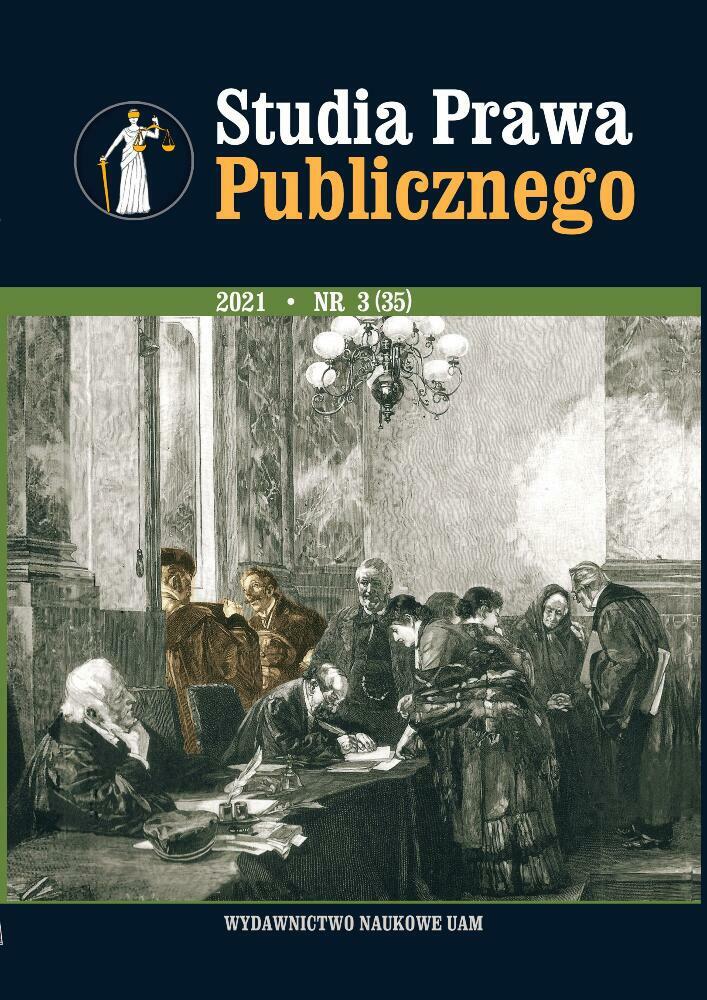Abstract
The article considers the legal status of the voivode during the interwar period, the time of the difficult restoration of the Polish identity and the creation of the Polish state in the post-Partition lands with three separate systems of territorial division and local administration. The legal situation of the office of the voivode is closely related to the establishment of the systemic foundations of the highest Polish authorities (legislative and executive) and local administration (initially, on the territory of the former Kingdom of Poland and then on the gradually annexed former Polish territories). The author refers to both spheres of legal activity of the Polish state at that time. She discusses the primary political acts, i.e. the March Constitution (1921), the April Constitution (1935) and the Constitutional Act (1926), as well as regulations concerning county administrative authorities of the first instance, situated in the then two-tier (ministries – county offices) administrative apparatus. Attention is primarily focused on the acts directly concerning the position of the voivode, i.e. the Act of 2 August 1919, the Regulation of the President of the Republic of 19 January 1928, and executive acts issued on the basis of these, and against whose background the importance of the legal institution of the voivode is presented: during the time of attempts to unify the administrative system (1918–1928), and in the period of changes leading to a uniform organisational structure of voivodship administrative authorities (1928–1939). The analysis makes it possible to state that successive legal conditions strengthened the political position of the voivode. In both periods covered by the analysis, the voivode was a representative of the government (with broader competences in 1928–1939), the executor of orders from individual ministers, the head of state and local government authorities and offices (1918–1928), the head of general administrative bodies subordinate to him, and the supervisory body over local government (1928–1939). The position of the voivode in the interwar period was unquestionably very strong.
References
Ajnenkiel A., Polska po przewrocie majowym, Warszawa 1980.
Ajnenkiel A., Administracja w Polsce. Zarys historyczny, Warszawa 1977.
Ajnenkiel A., Leśnodorski B., Rostocki W., Historia ustroju Polski (1764–1939), pod red. B. Leśnodorskiego, Warszawa 1970.
Albert A., Najnowsza historia Polski 1914–1993, Warszawa 1995.
Burda A., Polskie prawo państwowe, Warszawa 1969.
Chojnowski A., Wróbel P., Prezydenci i premierzy drugiej Rzeczypospolitej, Wrocław–Warszawa–Kraków 1992.
Ciągwa J., Autonomia Śląska w okresie II Rzeczypospolitej, w: Konstytucje Polski, t. 2, b.d.w.
Ćwik W., Mróz W., Witkowski A., Administracja w systemie ustrojowym Polski do 1939 r., Przemyśl 1998.
Dokumenty z dziejów polskiej polityki zagranicznej 1918–1939, t. 1: 1918–1932, pod red. T. Jędruszczaka, M. Nowak-Kiełbikowskiej, Warszawa 1989.
Jaroszyński M., Zimmermann M., Brzeziński W., Polskie prawo administracyjne. Część ogólna, Warszawa 1956.
Kasznica S., Polskie prawo administracyjne, Poznań 1947.
Korobowicz A., Mojak R., Skrzydło W., Zarys dziejów konstytucjonalizmu polskiego, Lublin 1996.
Kumaniecki K.W., Langrod J.S., Wachholz S., Zarys ustroju, postępowania i prawa administracyjnego w Polsce, Kraków–Warszawa 1939.
Kumaniecki K.W., Wasiutyński B., Panejko J., Polskie prawo administracyjne w zarysie, Kraków, b.d.w.
Leoński Z., Przekształcenia terenowego aparatu administracji państwowej, w: System prawa administracyjnego, t. 2, Wrocław 1977.
Maciejewski T., Historia ustroju Polski, Koszalin 1998.
Służewski J., Wojewoda w systemie administracji państwowej, Warszawa 1981.
Starościak J., Prawo administracyjne, Warszawa 1977.
Wasiutyński B., Ustrój władz administracyjnych, rządowych i samorządowych, Poznań 1953.
Witkowski W., Historia administracji w Polsce 1764–1989, Warszawa 2007.
License
Copyright (c) 2021 Krystyna Wojtczak

This work is licensed under a Creative Commons Attribution-NonCommercial-NoDerivatives 4.0 International License.

